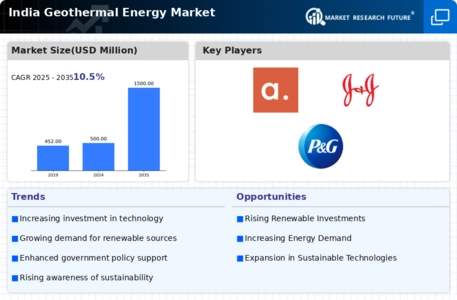Rising Energy Demand
The increasing energy demand in India is a pivotal driver for the India Geothermal Energy Market. As the population grows and urbanization accelerates, the need for sustainable and reliable energy sources intensifies. According to recent estimates, India's energy consumption is projected to rise significantly, necessitating a shift towards renewable energy sources. Geothermal energy, with its potential to provide a stable and continuous power supply, appears to be a viable solution. The government has recognized this need and is likely to promote geothermal projects to meet the rising energy demands, thereby enhancing the market's growth prospects.
Investment Opportunities
The potential for investment in the India Geothermal Energy Market is becoming increasingly attractive. With the global shift towards renewable energy, investors are looking for opportunities in emerging markets like India. The geothermal sector offers a unique proposition due to its ability to provide baseload power, which is essential for energy security. Recent reports indicate that investments in renewable energy projects, including geothermal, are expected to surge as the government continues to support infrastructure development. This influx of capital could lead to the establishment of new geothermal plants, enhancing the overall market landscape.
Technological Innovations
Technological advancements are transforming the landscape of the India Geothermal Energy Market. Innovations in drilling techniques, enhanced geothermal systems, and improved resource assessment methods are making geothermal projects more feasible and cost-effective. For instance, the development of binary cycle power plants has enabled the utilization of lower temperature geothermal resources, expanding the potential for geothermal energy generation. As these technologies continue to evolve, they are likely to attract investment and drive the growth of the geothermal sector in India, making it a more competitive player in the renewable energy market.
Government Policy and Regulation
The regulatory framework established by the Indian government is a significant driver for the India Geothermal Energy Market. Policies aimed at promoting renewable energy, such as feed-in tariffs and tax incentives, create a conducive environment for geothermal projects. The government has also initiated various programs to facilitate research and development in geothermal energy, which could lead to increased exploration and utilization of geothermal resources. As regulatory support strengthens, it is expected that more private players will enter the market, further stimulating growth and innovation in the geothermal sector.
Environmental Sustainability Goals
India's commitment to environmental sustainability is a crucial factor influencing the India Geothermal Energy Market. The country has set ambitious targets to reduce carbon emissions and increase the share of renewable energy in its energy mix. Geothermal energy, being a clean and renewable source, aligns well with these sustainability goals. The government aims to achieve 500 GW of renewable energy capacity by 2030, and geothermal energy could play a significant role in this transition. This focus on sustainability not only encourages investment in geothermal projects but also fosters innovation in technology and infrastructure, potentially leading to a more robust market.














Leave a Comment